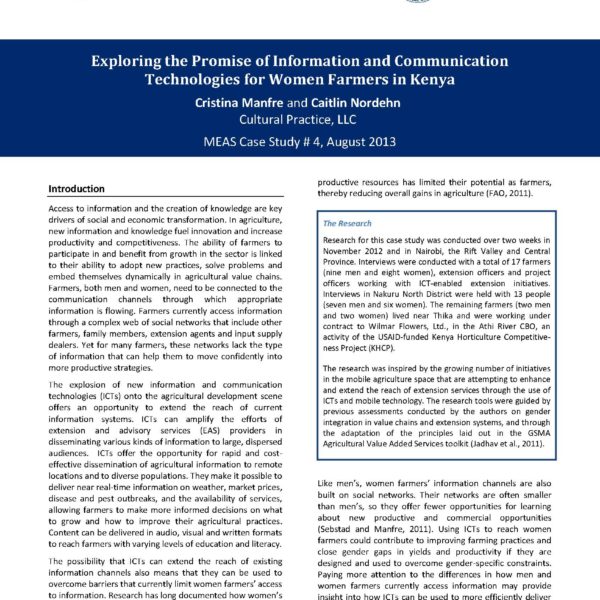Access to information and the creation of knowledge are key drivers of social and economic transformation. In agriculture, new information and knowledge fuel innovation and increase productivity and competitiveness. The ability of farmers to participate in and benefit from growth in the sector is linked to their ability to adopt new practices, solve problems and embed themselves dynamically in agricultural value chains. Farmers, both men and women, need to be connected to the communication channels through which appropriate information is flowing. Farmers currently access information through a complex web of social networks that include other farmers, family members, extension agents and input supply dealers. Yet for many farmers, these networks lack the type of information that can help them to move confidently into more productive strategies.
The explosion of new information and communication technologies (ICTs) onto the agricultural development scene offers an opportunity to extend the reach of current information systems. ICTs can amplify the efforts of extension and advisory services (EAS) providers in disseminating various kinds of information to large, dispersed audiences. ICTs offer the opportunity for rapid and cost-effective dissemination of agricultural information to remote locations and to diverse populations. They make it possible to deliver near real-time information on weather, market prices, disease and pest outbreaks, and the availability of services, allowing farmers to make more informed decisions on what to grow and how to improve their agricultural practices. Content can be delivered in audio, visual and written formats to reach farmers with varying levels of education and literacy.
The possibility that ICTs can extend the reach of existing information channels also means that they can be used to overcome barriers that currently limit women farmers’ access to information. Research has long documented how women’s lack of access to land, information, credit and other productive resources has limited their potential as farmers, thereby reducing overall gains in agriculture (FAO, 2011).
Like men’s, women farmers’ information channels are also built on social networks. Their networks are often smaller than men’s, so they offer fewer opportunities for learning about new productive and commercial opportunities (Sebstad and Manfre, 2011). Using ICTs to reach women farmers could contribute to improving farming practices and close gender gaps in yields and productivity if they are designed and used to overcome gender-specific constraints. Paying more attention to the differences in how men and women farmers currently access information may provide insight into how ICTs can be used to more efficiently deliver agricultural messages. Understanding the deficiencies in these networks will illuminate how ICTs can more effectively align the content of information with both men and women farmers’ needs. This case study examines the information channels and use of ICTs by men and women farmers around Nakuru and Thika in Kenya (Box). It contributes to a growing body of literature that aims to understand how ICTs can close gender gaps in agriculture and lead to more equitable opportunities for farmers.

